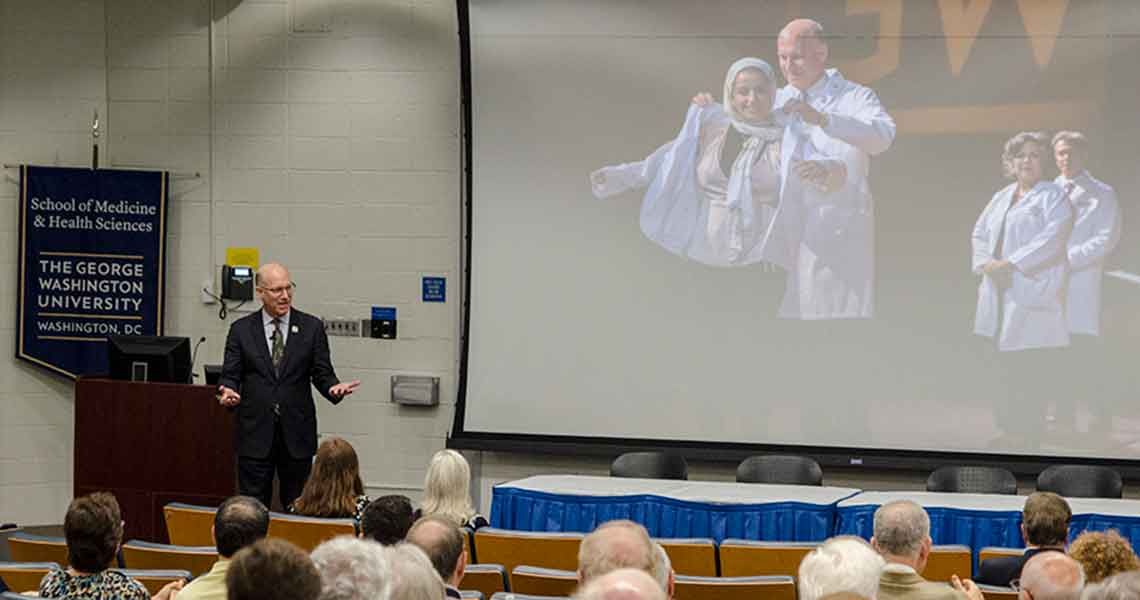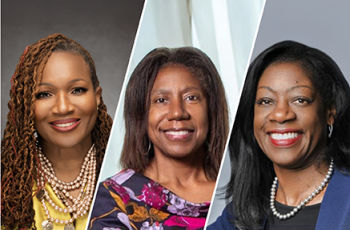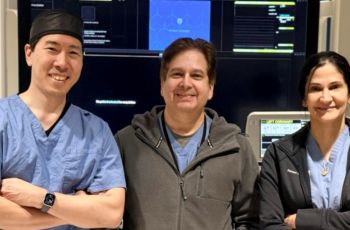Many of the 256 GW School of Medicine and Health Sciences (SMHS) MD program alumni and guests on hand for the 2017 Reunion Weekend Sept. 15–17 took time out from reminiscing and exploring the updated facilities to catch up on their alma mater’s latest developments during the annual State of the School Address.
The sometimes raucous crowd of alumni, celebrating graduation anniversaries from 10th to 50th, listened as Jeffrey S. Akman, MD ’81, RESD ’85, vice president for health affairs, Walter A. Bloedorn Professor of Administrative Medicine, and dean of SMHS, gave an overview of some of the major developments at the school, starting with the incoming class of MD students.
“Our students are amazing,” Akman told the assembled alumni from the classes of 1967, 1977, 1982, 1987, 1992, 1997, and 2007. “You probably know that we are one of the most selective MD programs in the country. We have about 175–180 students in each class, but each year we get more than 14,000 applications for those positions.”
Women make up 62 percent of the class of 2021, Akman continued, and more than 80 percent of those incoming students have had significant research backgrounds. The class includes a Fullbright scholar, Peace Corps and AmeriCorps volunteers, and military veterans. “This is a very diverse group of students,” Akman said, adding that, according to the Association of American Medical Colleges, SMHS is now among the top 10 percent in diversity. “We have worked hard to ensure that we have a student population that is as reflective as possible of the community in which our school serves. Our student body is diverse in every measure: socioeconomically, racially, ethnically. This is a really important and rich part of our identity.”
As a segue to some of the school’s clinical accomplishments, particularly the growth of GW’s kidney transplant program, the dean played a news report about fourth-year medical student Jacob Lambdin, one of several members of the SMHS community to donate one of his kidneys.
In August, the GW Transplant Institute celebrated its 100th transplant since the program started a little over two and a half years ago. Lambdin was one of the growing number of live donors to make an undirected organ donation.
“If I don’t need two kidneys and can live my life healthy, why can’t I help someone live,’” Lambdin said in the interview. “Ultimately, it comes down to donating is a good thing to do, and I don’t think it’s more complicated than that.”
Continuing with the clinical theme, Akman cited the close association with clinical partners GW Hospital and the GW Medical Faculty Associates (MFA). “Our partnerships with the GW Hospital and the GW MFA are critical to delivering the highest level of care for our patients and training for our students and residents. We have real strengths in the neurosciences and stroke care, cardiology, and in emergency medicine, disaster medicine, and trauma care.”
The dean also addressed the school’s growing portfolio of health sciences programs, not only touching on the continued successes of the top-ranked Physician Assistant and Physical Therapy programs, but also drawing specific attention toward many of the distance education programs. “We have more distance education programs and students at the School of Medicine and Health Sciences than in any other part of the university,” he said. “We have programs in health care quality, medical informatics, clinical management and leadership, among others. … You really should pull up the school website and look at the many health sciences programs. You will be astounded by [what] we have to offer.”
A key area of emphasis for SMHS, and the university as a whole, has been the growth of the research portfolio by investing in research recruits and developing laboratories and equipment. “It’s important, not only in terms of maintaining our stature as a leading academic medical center and participating in the advancement of scientific knowledge, but also our students, residents, and fellows have come to expect research opportunities as a key part of their medical education,” explained Akman. “It is critical that we provide these opportunities to our students.”
Overall, research grants have risen significantly at SMHS, from 82 new awards in 2016 to 94 new awards in 2017, with a total value of $67.3 million.
“You can see our investments are paying off as we have increased the number of our awards, the number of grant proposals, the number of principal investigators, and our total grant portfolio continues to go up,” he said.
When you add Children’s National Health System (Children’s National), Akman continued, “then you are talking about another $20–$25 million in research expenditures.
“We have a large grant in partnership with Children’s National, called the Clinical and Translational Science Award,” Akman told the crowd. “That helps us grow our scientific collaboration as well as helps train our faculty and develop their research careers. We are starting to become a significant research enterprise.”
To close his address, Akman acknowledged the important contributions SMHS alumni make once they leave Foggy Bottom.
“This is a photo of Lieutenant General Nadja Y. West, MD ’88, who served as the keynote speaker at the 2017 MD Diploma Ceremony and received an honorary degree during GW’s Commencement ceremonies on the National Mall,” Akman told the audience. “Dr. West is the Surgeon General of the Army. … She has broken more glass ceilings as a woman, as an African American, than almost anyone. She is actively engaged with the school, and she is an example of the quality of our alumni. I call attention to her as a way of acknowledging all you do every day in your lives and careers.
“When you look at the impact we have as a school,” Akman concluded, “One of the most important things we do is generate alumni. We provide the education and the skills, and then we send you into your communities and the world, where you take that knowledge … and make a difference. We want you to be engaged, we want you to be connected, and we want you to express the pride you have in George Washington University.”



